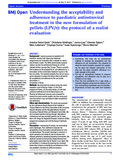| dc.contributor.author | Nebot, GiraltA1, Nöstlinger C1, Lee J2, Salami O3, Lallemant M2, Ouma O4, Nyamongo I4, Marchal B1. | |
| dc.contributor.author | Nebot, Giralt A | |
| dc.contributor.author | Nöstlinger, C | |
| dc.contributor.author | Lee, J | |
| dc.contributor.author | Salami, O | |
| dc.contributor.author | Lallemant, M | |
| dc.contributor.author | Ouma, O | |
| dc.contributor.author | Nyamongo, I | |
| dc.contributor.author | Marchal, B | |
| dc.date.accessioned | 2017-05-12T12:19:35Z | |
| dc.date.available | 2017-05-12T12:19:35Z | |
| dc.date.issued | 2017 | |
| dc.identifier.citation | BMJ Open. 2017 Mar 29;7(3):e014528. doi: 10.1136/bmjopen-2016-014528. | en_US |
| dc.identifier.uri | https://www.ncbi.nlm.nih.gov/pubmed/28360249 | |
| dc.identifier.uri | http://hdl.handle.net/11295/100896 | |
| dc.description.abstract | BACKGROUND:
Improving access to paediatric HIV treatment requires both large-scale treatment programmes and medication that is adapted to infants and children's needs. The WHO recommends lopinavir/ritonavir as first-line antiretroviral therapy for all HIV-infected children younger than 3 years. There is currently little evidence on the acceptability of, and adherence to, a formulation of this combination treatment if given in the form of pellets. This protocol presents how we will carry a realist evaluation to assess the factors that contribute to the acceptability and adherence to the new pellets formulation in 3 hospitals in Kenya.
METHODS:
We structured the protocol along the realist evaluation cycle following 4 steps: (1) the initial programme theory, (2) the study design, (3) the data collection methods and (4) the data analysis plan. Theories of behavioural sciences were reviewed for frames that could provide insights into how using such new formulations may contribute to better acceptability and adherence.
ETHICS AND DISSEMINATION:
This study was approved by the Institutional Review Board of the Institute of Tropical Medicine, the Ethical Committee of the University Hospital Antwerp and the Kenyatta National Hospital/University of Nairobi Ethics and Research Committee. We aim to disseminate the findings through international conferences and peer-reviewed journals and to share them with Drugs for Neglected Diseases initiative's (DNDi) programme managers and with the Kenyan healthcare providers.
DISCUSSION:
In developing this study, we encountered some challenges. First, methods to measure the acceptability of any formulation and adherence to it are not standardised. The second challenge is common in realist evaluation and relates to how to choose from different potentially interesting theoretical frameworks. We identified relevant and empirically tested theories from behavioural science that may be helpful in our study. We will test them in 3 settings by exploring the multilevel factors that influence acceptability and adherence of this new paediatric Antiretroviral (ARV) formulation.
Published by the BMJ Publishing Group Limited. For permission to use (where not already granted under a licence) please go to http://www.bmj.com/company/products-services/rights-and-licensing/. | en_US |
| dc.language.iso | en | en_US |
| dc.publisher | University of Nairobi | en_US |
| dc.rights | Attribution-NonCommercial-NoDerivs 3.0 United States | * |
| dc.rights.uri | http://creativecommons.org/licenses/by-nc-nd/3.0/us/ | * |
| dc.subject | Kenya; Paediatric antiretroviral treatment; acceptability; adherence; realist evaluation | en_US |
| dc.title | Understanding the acceptability and adherence to paediatric antiretroviral treatment in the new formulation of pellets (LPV/r): the protocol of a realist evaluation. | en_US |
| dc.type | Article | en_US |



